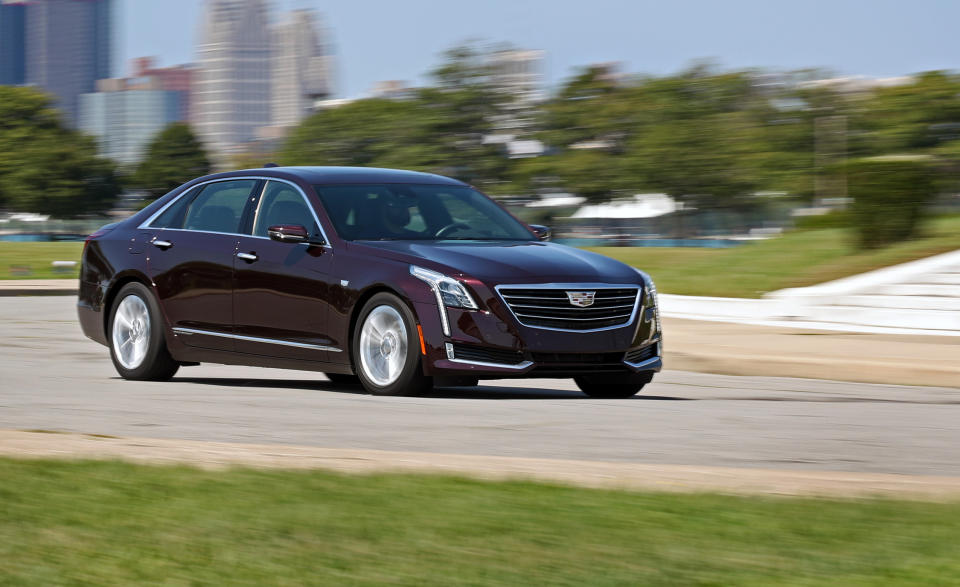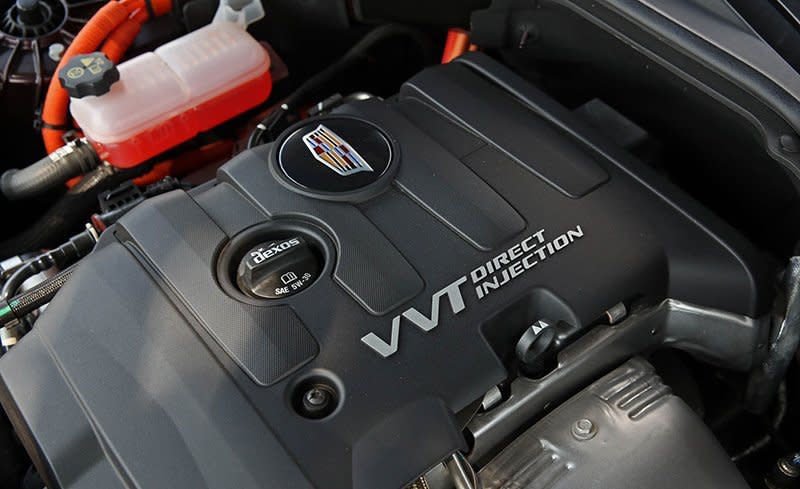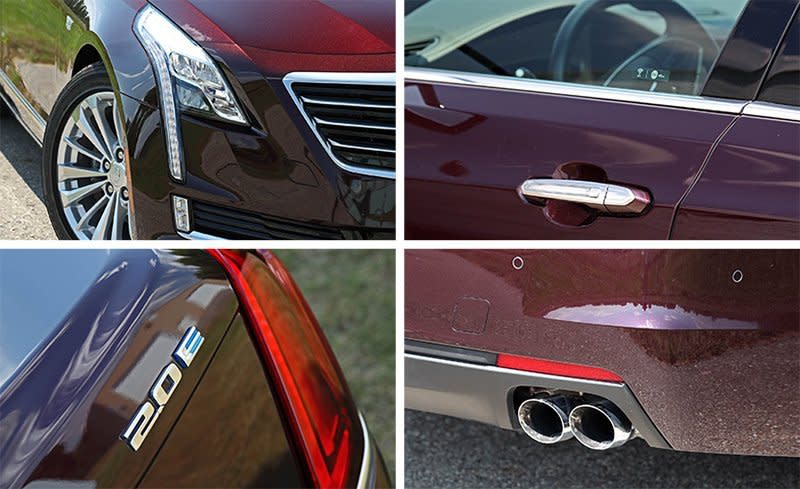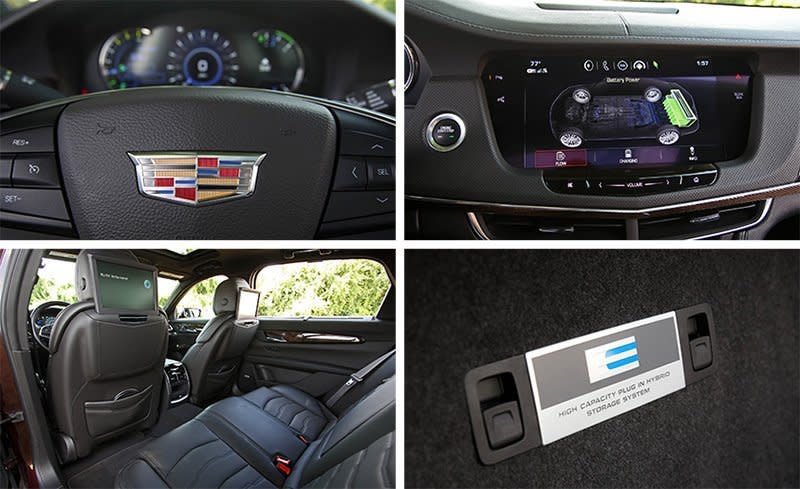2017 Cadillac CT6 Plug-In Hybrid

After a busy few years that included the launch of the ATS, the third-gen CTS, exciting V performance variants of both, a redesigned Escalade, a new XT5 crossover, and a new CT6 large sedan, Cadillac has gone quiet for a stretch. The only new product that has hit the streets since early 2016 is this plug-in-hybrid version of the not quite flagship CT6 sedan.
A plug-in CT6 isn’t much of a surprise, given the rise of electrification among luxury automakers, notably the CT6’s key German rivals, the BMW 7-series and the Mercedes-Benz S-class. Plug-in hybrids also are becoming increasingly crucial in the expanding Chinese market, where Cadillac now sells more cars than it does in the United States. So the pluggable CT6 comes to our shores by way of Shanghai, where it’s assembled alongside other China-market CT6 sedans (conventionally powered U.S.-market CT6 models are built in Michigan).

The Dirty Bits
Even though the hybrid isn’t expected to make up a large portion of CT6 sales in the States, the car’s significance in China means that General Motors saw fit to engineer an entirely new gas-electric powertrain. (The transverse hybrid unit from the front-drive Chevrolet Volt wouldn’t work in a rear-wheel-drive car with a longitudinal drivetrain orientation like the Cadillac.) The new system pairs the base CT6’s standard turbocharged 2.0-liter inline-four with two electric motors housed in the transmission. An 18.4-kWh lithium-ion battery pack provides an EPA-rated 31 miles of electric-only range, more than twice what the BMW 740e offers from its smaller 9.2-kWh battery pack.
Altogether, the Cadillac’s drivetrain puts out 335 horsepower and 432 lb-ft of torque, landing it smack dab in the middle of the CT6’s conventional gasoline drivetrain options, which include the aforementioned 265-hp turbo 2.0-liter four, a 335-hp 3.6-liter V-6, and a 404-hp twin-turbo 3.0-liter V-6. But the way that the CT6 plug-in delivers its torque to the ground is decidedly more complex. The three power sources combine their efforts in a transmission consisting of three planetary gearsets, five clutches, and two motors that is capable of four variable gear-ratio spreads and three fixed gear ratios. (Cadillac calls this assembly an EVT, for electric variable transmission.) All in all, this drivetrain has 11 different operating states, although only eight of those actually propel the car—the others are used only in specific, infrequent scenarios such as engine-on regenerative braking at high speeds or to help transition among other operating states. Got all that?

If your craving for numbers still isn’t satisfied, consider the CT6 hybrid’s performance at the test track. It recorded a swift zero-to-60-mph time of 5.2 seconds, matching both Cadillac’s own estimate and the 740e’s performance in the same test. It also beat the base CT6 2.0T by 0.9 second and the mid-level 3.6L V-6 by 0.7 second—the top-dog 3.0-liter twin-turbo V-6 is only a hair quicker, at 5.0 seconds. The gas-electric CT6 continues to pull strongly through the quarter-mile, which arrived in 13.8 seconds at 102 mph, and the car can even reach a governed top speed of 152 mph.
Wide Variety of Behaviors
There’s more to this hybrid’s propulsion story in real-world driving, as the Cadillac’s character varies greatly depending on how you drive it. In all-electric mode, the CT6 accelerates in a smooth, linear, and quiet fashion, like most EVs. The electric motors can power the sedan up to 78 mph, and the four-cylinder only fires up to provide extra power once you’re well past halfway through the accelerator pedal’s travel. When this happens, you will notice a significant delay between your right foot’s input and the powertrain’s reaction, which can be unnerving while merging into traffic or trying to make a quick left turn.
We found the range estimate of 31 all-electric miles to be entirely believable, especially when we made use of the adjustable regenerative braking system. It’s operated by paddles on the steering wheel, which toggle four “gears” that don’t actually have anything to do with the transmission. Instead, placing the console shifter in manual mode and then using the paddles progressively increases the amount of regenerative braking as you go from 4 to 3 to 2 to 1. In 1, the regen can bring the car nearly to a full stop. True one-pedal driving can be achieved by combining the lowest regen mode with the automatic brake-hold feature.

When its electric range has been depleted, the CT6 operates like a typical parallel hybrid, switching between the electric motors and the gas engine as needed. The drivetrain is well isolated from the cabin, meaning that your passengers won’t often notice any unconventional behavior. However, the combination of the variable ratio spreads with the three fixed gear ratios means that the 2.0-liter engine sometimes seems to have a mind of its own, revving in ways that don’t always correspond to inputs from your right foot. When slowing to a stop, for instance, sometimes the engine revs increase briefly—Cadillac says that this is caused by the transmission essentially “downshifting” through the lowest fixed gear ratio into the lowest EVT ratio spread.
Agility and Efficiency
Despite all the added complexity, the plug-in CT6 ends up weighing only 92 pounds more than a loaded 3.0TT model, by our measurements, and 360 pounds more than a 3.6L sedan. Both of those CT6s have standard all-wheel drive, which isn’t available for the hybrid, but the relative lightness of the CT6 plug-in—a BMW 740e xDrive plug-in weighs 204 pounds more—gives it the same impressive dynamics that we’ve found in the conventional versions. The CT6 hybrid changes direction eagerly, its steering wheel is communicative, and its ride is firm and composed, making it much more enjoyable to pilot than the floaty and ponderous BMW.
The 740e—the CT6’s only obvious competitor now that the Mercedes-Benz S550e plug-in has disappeared with the S-class’s 2018 refresh—does have a slight edge on the Cadillac when it comes to efficiency. The EPA rates the BMW at 64 MPGe combined while using electric power and 27 mpg combined in hybrid mode, slightly above the Cadillac’s 62 MPGe and 26 mpg numbers. That discrepancy played out in our real-world testing, where the 740e achieved a 35-mpg result on our 75-mph highway test, to the CT6’s 31 mpg.

Priced Right
As it does with the standard CT6, Cadillac aggressively prices this full-size hybrid luxury sedan. The CT6 plug-in comes in a monospec configuration, including standard equipment such as adaptive cruise control, a panoramic sunroof, and a rear-seat entertainment system, all for $76,090. That’s about $15,000 less than the 740e’s base price and $20,000 cheaper than the outgoing S550e, and those sedans require numerous expensive option packages to get many of the features that come standard on the Cadillac. The hybrid also costs only a few thousand dollars more than a comparably equipped CT6 with the twin-turbo 3.0-liter engine, the only conventional powertrain that can match the plug-in’s performance.
As with most hybrids, there are trade-offs, chief among them the reduced trunk capacity, which shrinks from 15 cubic feet down to 11. Compared side by side with the 7-series, the CT6 lacks visual presence and interior lavishness, shortcomings made forgivable by its much lower price. This Cadillac hybrid’s strengths—namely its electric range, lively handling, and good value proposition—outweigh its weaknesses, even if it won’t be much more than a blip on Cadillac’s sales radar.
Specifications >
VEHICLE TYPE: front-engine, rear-wheel-drive, 5-passenger, 4-door sedan
PRICE AS TESTED: $76,090 (base price: $76,090)
ENGINE TYPE: turbocharged and intercooled DOHC 2.0-liter inline-4, 265 hp, 295 lb-ft;
1 permanent-magnet synchronous AC motor and 1 induction AC motor;
combined output, 335 hp, 432 lb-ft;
18.4-kWh lithium-ion battery pack
TRANSMISSION: continuously variable automatic
DIMENSIONS:
Wheelbase: 122.4 in
Length: 204.0 in
Width: 74.0 in Height: 57.9 in
Passenger volume: 113 cu ft
Trunk volume: 11 cu ft
Curb weight: 4498 lb
C/D TEST RESULTS:
Zero to 60 mph: 5.2 sec
Zero to 100 mph: 13.2 sec
Zero to 130 mph: 21.8 sec
Zero to 150 mph: 31.3 sec
Rolling start, 5–60 mph: 5.4 sec
Top gear, 30–50 mph: 3.4 sec
Top gear, 50–70 mph: 4.4 sec
Standing ¼-mile: 13.8 sec @ 102 mph
Top speed (governor limited): 152 mph
Braking, 70–0 mph: 177 ft
Roadholding, 300-ft-dia skidpad: 0.84 g
C/D FUEL ECONOMY:
75-mph highway driving, EV/hybrid mode: 69 MPGe/31 mpg
Highway range, EV/hybrid mode: 33/480 mi
EPA FUEL ECONOMY:
Combined/city/highway: 26/23/29 mpg
Combined gasoline+electricity: 62 MPGe
EV range: 31 miles

 Yahoo Autos
Yahoo Autos 